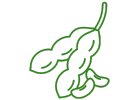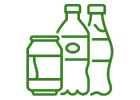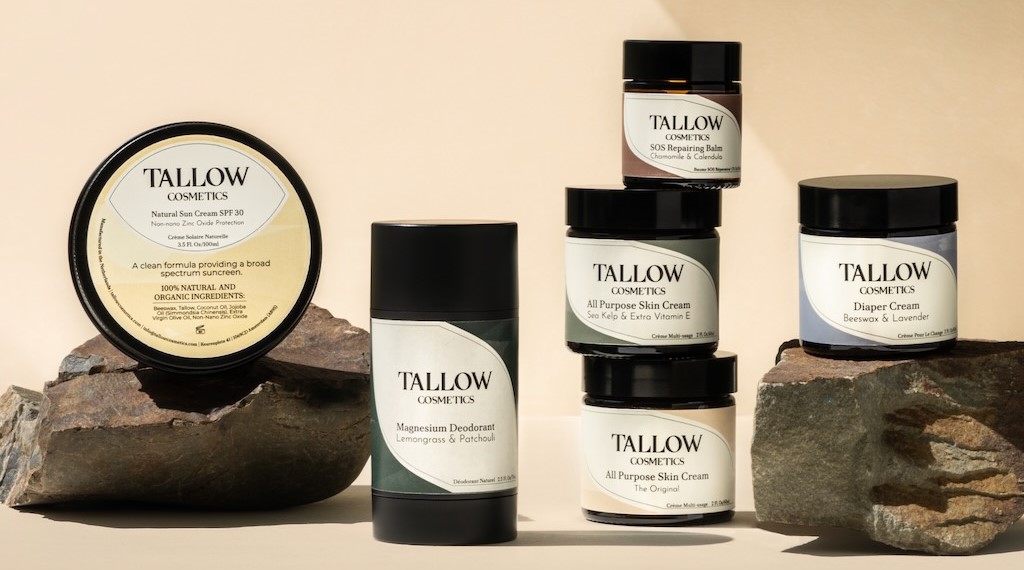Percarbonate activator - TAED přírodní bělící přípravek pro praní i úklid - 3 kg, 5 kg
What is TAED?
Tetraacetylethylenediamine, abbreviated TAED (CAS 10543-57-4) from Czech producer Qualt Rakovník, is an organic compound that is widely used as a bleach activator in detergents. It has an active role in the cleaning process, allowing safe and effective results at lower temperatures.
TAED is an important ingredient in detergents as an alternative to "active oxygen" bleaching agents, from sodium perborate to carbamide peroxide. While typical "active oxygen" agents work by releasing hydrogen peroxide during the wash cycle, this effect is only possible at temperatures below 60 °C (140 °F).
In contrast, TAED and its ability to form peroxyacetic acid allows for effective cleaning and bleaching results at lower wash cycle temperatures.
Powdered TAED can be easily stabilized by granulation with the support of sodium carboxymethylcellulose (Na-CMC). Despite the relatively low solubility of TAED in cold water, the granules dissolve effectively in the washing solution within a few minutes. Once the washing process is started, it dissolves easily and quickly in its entirety.
Currently, TAED is the main bleach activator used in European detergents, with significant annual consumption. Typical TAED concentrations in different products range from 1.4% to 13%.
Is TAED non-toxic and biodegradable?
TAED is essentially non-toxic and readily biodegradable. Triacetyl ethylenediamine and its by-product DAED have low aquatic ecotoxicity and very low toxicity for all routes of exposure. TAED, TriAED and DAED are fully biodegradable and are effectively removed in wastewater treatment.
TAED is also not teratogenic or mutagenic. Its properties as a detergent ingredient help in reducing energy consumption, which in turn minimizes the environmental impact of the process.
TAED has no irritating effects on the skin and eyes. It also does not cause any signs of skin sensitisation due to prolonged exposure, for example during hand washing.
Use in the home
The majority of TAED consumption in households is for use as a bleaching activator in laundry detergents. It is a highly effective product that can whiten a wide range of tough stains, from tea and coffee to wine and food.
It also contributes significantly to the overall whiteness of the laundry. As a detergent ingredient, TAED is also active in removing unpleasant odours thanks to its antimicrobial efficacy, while remaining gentle on fibres.
Thanks to the TAED listed in the formula, stains such as coffee, tea, coffee and fruit juices can be effectively removed at a water temperature as low as 15 °C.
Use in industry
Tetraacetylethylenediamine (TAED) is commonly used in the household cleaning products industry as a peroxide bleach activator. TAED is an important ingredient in detergents and bleaches, where it is used as an alternative active agent instead of sodium perborate, sodium percarbonate, sodium perphosphate or sodium persulfate.
Other applications of TAED include paper pulp production (paper bleaching). It can be found in preparations for automatic dishwashers, as an active ingredient in common disinfectants and as a sterilising agent in various detergents and solutions for medical use.
Tetraacetylethylenediamine reacts with hydrogen peroxide to form peracetic acid, which is a strong bleaching agent and a biocide that does not harm paints. The resulting compound has strong bactericidal, virucidal and fungicidal properties, allowing TAED to disinfect and deodorize.
It is also used as a surfactant in soap bars, light detergents and dishwashing detergents, and as a bleaching agent for cottonseed. CDEA can be added to lauryl sulfate-based liquid cleaners to help stabilize and improve foam formation.
Diethanolamine condensate from coconut oil is a corrosion inhibitor in aqueous, semi-synthetic and synthetic metalworking fluids and is also found in polishing agents. As an antistatic agent, it is found in plastics, for example in polyethylene films for food packaging and in rigid polyvinyl chloride. In combination with metal salts, it acts as an antistatic agent for polystyrene and in impact-resistant rubber and polystyrene compounds.
Other uses include electroplating, shoe polish, printing ink and more.
It is also used as a surfactant in soap bars, light detergents and dishwashing detergents, as well as a de-inking agent for cottonseed. CDEA can be added to lauryl sulfate-based liquid cleaners to help stabilize and improve foam formation.
Diethanolamine condensate from coconut oil is a corrosion inhibitor in aqueous, semi-synthetic and synthetic metalworking fluids and is also found in polishing agents. As an antistatic agent, it is found in plastics, for example in polyethylene films for food packaging and in rigid polyvinyl chloride. In combination with metal salts, it acts as an antistatic agent for polystyrene and in impact-resistant rubber and polystyrene compounds.
Other uses include electroplating, shoe polish, printing ink and more.
Dosage
The recommended dosage is 3-5% TAED to sodium percarbonate. I.e. 30 g - 50 g per kilogram of sodium percarbonate. TAED releases peroxide from percarbonate at low temperature.
Production
The two stages of TAED production include ethylenediamine (ED) and acetic anhydride (Ac2O). In the first stage, ethylenediamine (ED) is diacetylated to DAED. In the second step, DAED is subsequently converted with acetic anhydride (Ac2O) by TriAED to form TAED. The final compound is crystallized from the reaction mixture and then filtered, washed and dried. If necessary, it can also be granulated. The production process leaves no by-products or residues.
The 1:2 mixture produces a lower quality coconut diethanolamide which contains residues of free diethanolamine and ethylene glycol. The higher quality 1:1 blend results in less free amine, making it suitable for use in lower concentrations than Coconut Diethanolamide 1:2.
The fatty acids that can be used in the process are coconut oil, methyl coconate, whole or stripped coconut acid.
The 1:2 mixture produces a lower quality coconut diethanolamide that contains residues of free diethanolamine and ethylene glycol. The higher quality 1:1 mixture results in less free amine, making it suitable for use in lower concentrations than coconut diethanolamide 1:2.
The fatty acids that can be used in the process are coconut oil, methyl coconate, whole or stripped coconut acid.
Solubility
Soluble in methylene chloride and chloroform, partially soluble in water and acetone.
Stability/durability
Stable.
Store in a cool, dry and dark place.
Under proper storage conditions, the shelf life of tetraacetylethylenediamine (TAED) is two years.
Additional parameters
| Category: | Detergents |
|---|---|
| Výrobce: | Qalt, Rakovník s.r.o., Zavídov 72, 27035, Petrovice |
| Země původu: | Česká Republika |
| Vhodné pro: | Citlivá pokožka |
Be the first who will post an article to this item!
Be the first who will post an article to this item!

Eco-friendly cleaning powders such as baking soda, citric acid and sodium percarbonate have historically been used for household cleaning due to their effective and non-toxic properties.
These natural substances are a safe alternative to conventional chemical cleaners, providing excellent results without negatively impacting the environment.
They also contribute to a clean and healthy home environment, are biodegradable and non-polluting, promoting sustainable living habits that build on a long tradition of using natural resources for cleaning.
What makes us unique?
- Environmental friendliness: These substances are biodegradable and do not leave toxic residues.
- Versatile use: from surface cleaning and stain removal to laundry bleaching and disinfection.
- Safety and non-toxicity: they do not contain aggressive chemicals and are non-toxic to humans and pets. They do not pose a health risk.
- Efficiency without compromise: Cleaning efficiency is comparable to conventional chemical agents.
-
Historically proven: they have been used for household cleaning for generations, proving their reliability and efficiency.
Benefits of organic powders
Baking Soda (Bicarbonate of Soda)
- Nature: It is biodegradable and leaves no toxic residue, making it an environmentally friendly choice.
- Home: Neutralises odours, removes stains and grease, making it a versatile cleaner for kitchens and bathrooms.
- Cleaning: the mildly abrasive properties allow gentle cleaning of surfaces without damaging them, making it ideal for glass, tile and stainless steel.


Baking soda (for use with vinegar)
- Nature: The combination of baking soda and vinegar creates a non-toxic mixture that breaks down into water and CO₂ when reacted, making it environmentally friendly.
- Home: Great for cleaning drains, loosening clogs and neutralising unpleasant odours in kitchens and bathrooms.
- Cleaning: the reaction of baking soda and vinegar helps remove grease stains and deposits, improving the overall cleanliness of surfaces.
Citric acid (as a plasticizer)
- Nature: It contains no synthetic substances and leaves no toxic residue after decomposition, making it environmentally friendly.
- Home: Naturally softens water, reducing the need for chemical softeners and improving the effectiveness of detergents.
- Cleaning: improves the effectiveness of cleaning products, helping to reduce the overall amount of chemicals needed while leaving surfaces clean and shiny.


Sodium percarbonate
- Nature: The combination of baking soda and vinegar creates a non-toxic mixture that breaks down into water and CO₂ when reacted, making it environmentally friendly.
- Home: Great for cleaning drains, loosening clogs and neutralising unpleasant odours in kitchens and bathrooms.
- Cleaning: the reaction of baking soda and vinegar helps remove grease stains and deposits, improving the overall cleanliness of surfaces.
Sodium percarbonate with TAED
- Nature: No harmful substances are produced during decomposition. Percarbonate decomposes into water, oxygen and sodium, while TAED is biodegradable, minimizing the negative impact on the environment and not burdening aquatic ecosystems.
- Household: TAED increases the effectiveness of percarbonate especially at low temperatures. This combination enables effective bleaching and stain removal even in cold water, saving energy and protecting fabrics from damage. In addition, it provides disinfecting effects that ensure cleaner and more hygienic washing.
- Cleaning: percarbonate with TAED produces peracetic acid, which is a strong oxidizing agent. It effectively removes organic stains, breaks down fats and proteins while disinfecting surfaces. Improves bleaching and cleaning efficiency and allows faster and more effective cleaning even at lower temperatures.


Tetraacetylethylenediamine (TAED)
- Nature: TAED is easily biodegradable and environmentally friendly. It activates bleach at lower temperatures, reducing energy consumption and stress on ecosystems.
- Home: Increases the effectiveness of sodium percarbonate, allowing for effective bleaching and disinfection at low temperatures. It saves energy and extends the life of textiles without the need to use aggressive chemicals.
- Cleaning: TAED activates percarbonate into a powerful oxidizing agent that effectively removes stains, breaks down organic matter and kills microorganisms. This ensures greater cleanliness and hygiene during cleaning.
Using these eco-friendly cleaning products not only promotes a healthier home environment, but also protects our planet from harmful chemicals.

.jpg)










































































